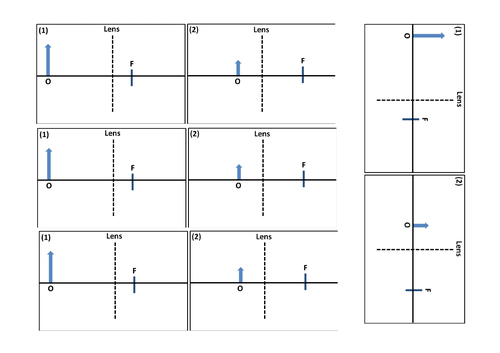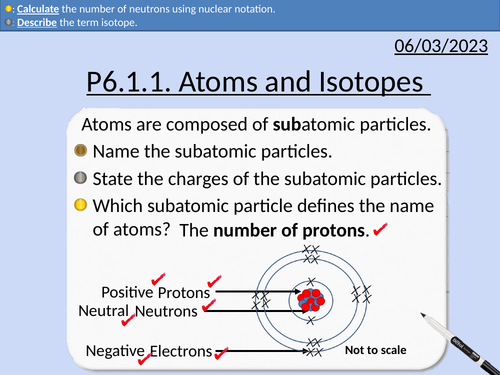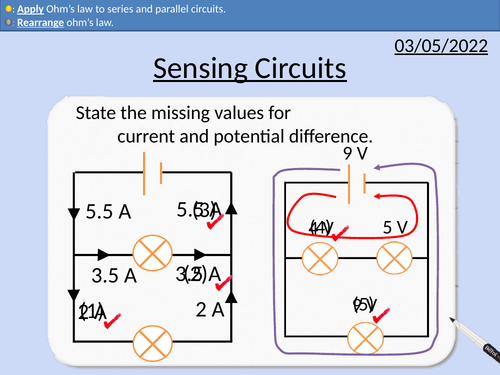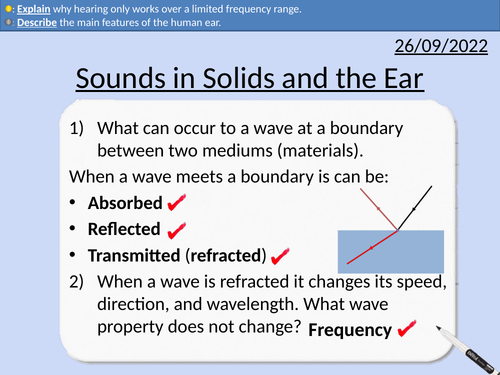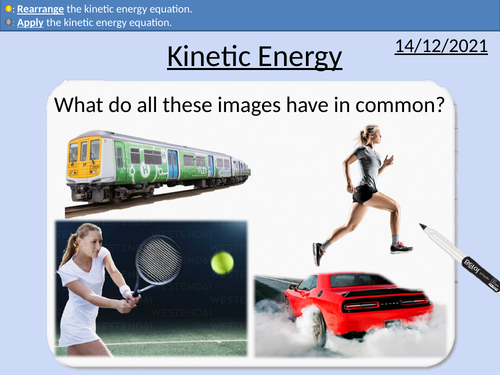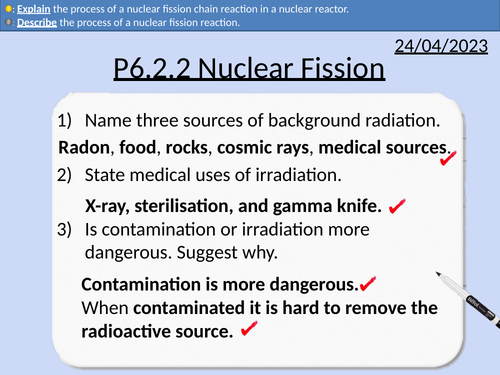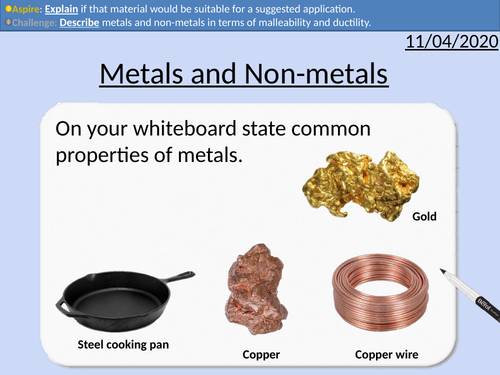497Uploads
169k+Views
72k+Downloads
All resources

GCSE Physics: Specific Latent Heat
This presentation covers OCR Gateway Physics 9-1 P1.2.4 Specific Latent Heat
Presentation covers
Changes of State - Phase changes
Interactive Graph
Equation with example
Questions with solutions for SLH equation
Exam style question with answer

GCSE Physics: Pressure and Volume
This presentation includes:
Pressure x Volume = Constant
Worked Examples
Plotting of pressure-volume graph
Explanation of increasing energy and temperature with bike pump

GCSE Physics: Lenses
This presentation covers OCR Gateway Physics 9-1 P5.3.2
Includes student activities and full worked answers.
Convex and Concaves lenses
Eyes and corrective lenses
Refraction and wavelength
Focal points for lenses
Determining the type of images produced through a lens

GCSE Physics: Atoms and Isotopes
This presentation covers OCR Gateway Physics 9-1 P6.1.1 Atoms and Isotopes
All presentations come with student activities and worked solutions.
Structure of atom
Properties of subatomic particles
Atomic Number
Mass Number
Nuclear Notation
Calculating the number of neutrons

GCSE Physics: Electromagnetic Waves
These presentations cover the OCR Gateway Physics 9-1 P5.2.1 Electromagnetic Waves. Includes student activities and full worked answers.
Order of the electromagnetic spectrum
Wavelength and frequency relationship
Application of wave speed equation
Rearranging equation
Producing and detecting radio waves

GCSE Physics: Sensing Circuits
This presentation covers OCR Gateway Physics 9-1 P3.2.7 Sensing Circuits
Potential difference in series and parallel circuits
Lamps in series and parallel
Gravitational potential and potential difference
LDR and Thermistor in potential divider circuits
Using LDRs to control security lights
Using thermistors to control heating/cooling circuits
Exam questions with worked solutions

GCSE Physics: Sound, Boundaries and Ultrasound
This presentation covers OCR Gateway Physics 9-1 P5.1.3 Sound Properties and Uses. Includes student activities and full worked answers.
Ray diagrams
Absorption, reflection and transmission
Sonar
Ultrasound
Rearranging equation
Refraction
Relationship between wave speed and wavelength
Data analysis

GCSE Physics: Sounds in Solids and the Ear
This presentation covers OCR Gateway Physics 9-1 P5.1.4 Sound in Solids and the Ear. Includes student activities and full worked answers.
Structure of the ear.
Frequency range of human hearing.
Explanation of the limited frequency range of humans.
Explanation for hearing deteriorating with age.

GCSE Physics: Imaging with Electromagnetic Waves
This presentation covers OCR Gateway Physics 9-1 P5.2.3 Imaging with Electromagnetic waves. Includes student activities and full worked answers.
Careers: Medical Physicist
X-rays
CT scans
Gamma imaging
Thermogram
Magnetic Resonance Imaging
Precautions for using ionising radiation

GCSE Physics: Graphs of Current and Potential Difference (I-V)
This presentation covers OCR Gateway Physics 9-1 P3.2.4 Graphs of potential difference (p.d.) and current.
Linear circuit element
Non-linear circuit element
Diodes and Light emitting diode (LED)
Current against potential difference graphs
How the gradient of a current against potential difference graph relates to resistance
Experimental set-up for determining circuit elements
How temperature affects resistance in lamps and metal conductors (wires)

GCSE Physics: Acceleration
This presentation covers OCR Gateway Physics 9-1 P1.2.3.
Content covered:
Definition for acceleration
Worked solutions
Students problems with answers
Exam style question with mark scheme

GCSE Physics: Kinetic Energy
This presentation covers OCR Gateway Physics 9-1 P2.1.6
Kinetic equation
Rearranging equations with three different methods.
Plotting velocity vs kinetic energy
Evaluating square relationships
Worked problems with solutions
Student problems with solutions

GCSE Physics: Nuclear Fission
This presentation covers OCR Gateway Physics 9-1 P6.2.2 Nuclear Fission
This PowerPoint is a whole lessons included with student activities and animated answers.
Conservation of mass
Uranium as a nuclear fission fuel
Nuclear fission process
Chain reactions in nuclear fission reactions
Control rods and moderators in nuclear reactors
Benefits and disadvantages of nuclear fission reactors.
Mass-Energy Equivalence

GCSE Physics: Kinetic and Gravitational Energy
This presentation covers OCR Gateway Physics 9-1 P7.1.6 Kinetic and Gravitational Energy
Rearranging Gravitational and Kinetic Energy Equations
Energy Transfers and conservation of energy
Historical Development of physics and pendulums
Creating an experiment to prove conservation of energy
Exam question with worked solutions
Practice questions with worked solutions

GCSE Physics: Motors
This presentation covers OCR Gateway Physics 9-1 P4.2.2 Construction of a motor.
Magnetic Field Lines
Construction of a commutator
How to increase the speed of a motor.
Student activities with worked solutions.

GCSE Physics: Acceleration Practical
This PowerPoint presentation with worked examples and student questions covers:
• Acceleration experiment protocol
• Ensuring results are reproducible and repeatable
Spotting and removing anomalies.
Rearranging equations

GCSE Physics: Potential Difference
This PowerPoint presentation with worked examples and student questions covers:
• Modelling potential difference and current
• Circuit symbols and units
• Measuring potential difference
• Series and Parallel circuits

GCSE Chemistry: Development of the Atomic Model
This PowerPoint presentation with worked examples and student questions covers:
• Dalton, Thomson, Rutherford and Bohr’s models
• Comparing different scientific models of the atom

GCSE Chemistry: Metals and Non-metals
This PowerPoint presentation with worked examples and student questions covers:
• Using the periodic table to identify metals and non-metals
• Different properties of metal and non-metals (Appearance, melting and boiling point, state of matter at room temperature, ductility, and malleability).
• Exceptions of physical properties (mercury being liquid and carbon conducting electricity).

GCSE Chemistry: Simple Molecules
This PowerPoint presentation with worked examples and student questions covers:
• Dot and cross diagrams of simple molecules
• Simple molecules form covalent bonds
• The group number on the periodic table informs us how many electrons are in the outer shell.
• Groups on the periodic table



